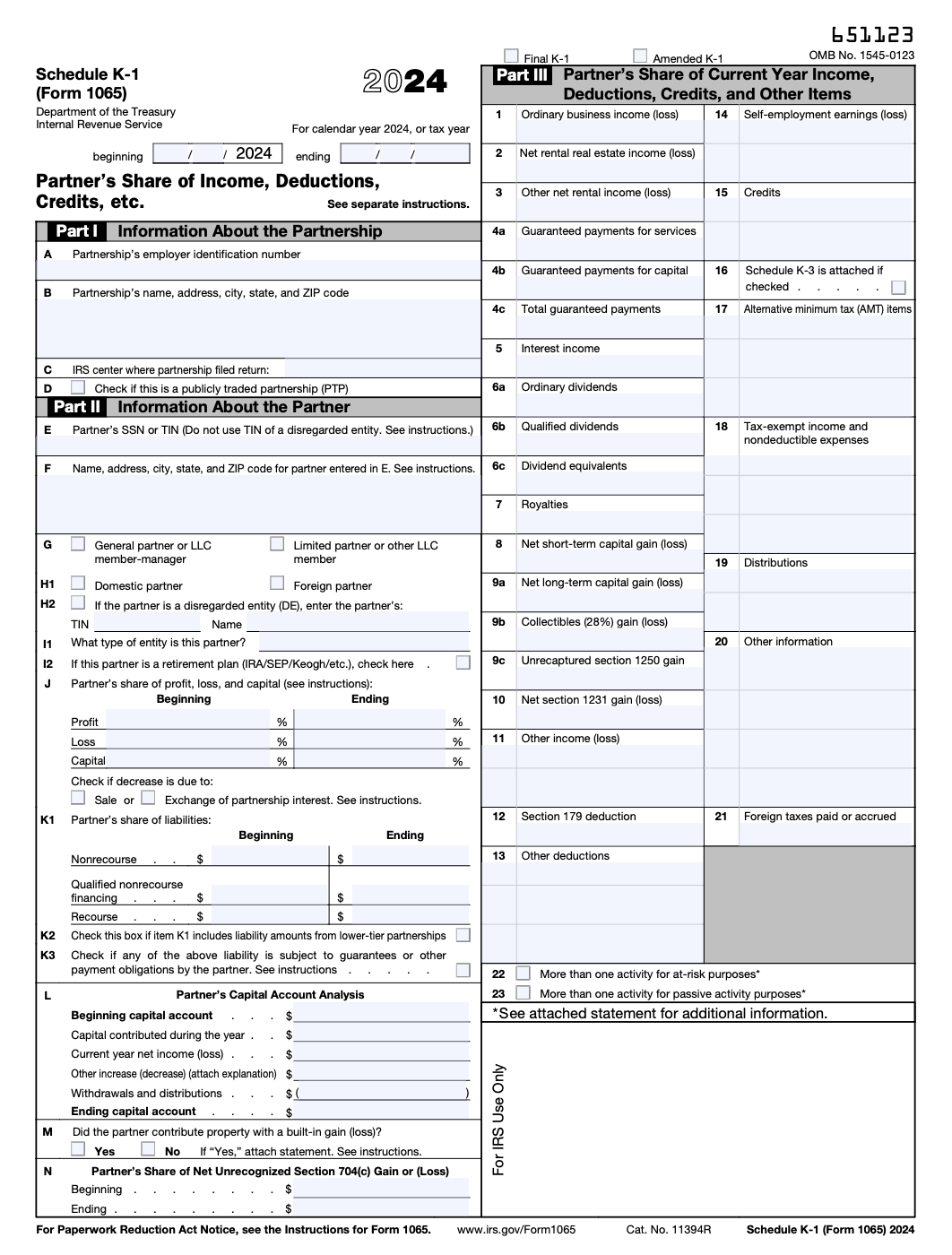If you’re a partner in a business, your tax filing hinges on one critical document: Schedule K-1 (Form 1065). Many taxpayers get confused when they receive this form in the mail because it looks different from a traditional W-2 or 1099. Instead of showing straightforward wages or income, a Form 1065 K-1 reports your share of the partnership’s income, deductions, and credits.
Unlike corporations that pay taxes directly, partnerships are “pass-through” entities. That means the business itself doesn’t pay federal income tax. Instead, profits and losses “pass through” to the partners, who report them on their personal tax returns using the Schedule K-1 Form 1065.
This blog will walk you through the essentials:
- What exactly the Form 1065 K-1 is,
- Who receives it, and
- The deadlines, requirements, and FAQs that matter most.
By the end, you’ll understand not just what this form is, but how it directly affects your tax filing and compliance with the IRS.
Table of Content
What is Form 1065 Schedule K-1?
The Schedule K-1 Form 1065 is an official IRS tax document that partnerships use to report each partner’s share of the business’s income, deductions, credits, and other financial items. Here’s how it works:
- The partnership files Form 1065, U.S. Return of Partnership Income, with the IRS to report the overall income, deductions, and credits of the business.
- Once that’s done, the partnership prepares a Schedule K-1 (Form 1065) for each partner. This shows the exact breakdown of what portion of those items belongs to them.
Example:
Suppose a two-partner business earns $100,000 in profit for the year. If each partner owns 50%, each will receive a Schedule K-1 Form 1065 showing $50,000 as their share of income. That $50,000 is then reported on each partner’s individual tax return (Form 1040).
Key Difference:
- Form 1065 = filed by the partnership with the IRS.
- Schedule K-1 (Form 1065) = issued to each partner so they can file their personal taxes.
This distinction is crucial because while the business itself doesn’t pay federal income tax, the partners are responsible for reporting and paying taxes on their share.

Who Needs to File or Receive a Schedule K-1?
Not everyone deals with a Form 1065 K-1, but if you’re involved in certain business structures, it’s unavoidable.
- Partnerships: Every partnership that files a Form 1065 must prepare a Schedule K-1 for each partner.
- LLCs taxed as partnerships: If your LLC elected partnership taxation, each member will also receive a Schedule K-1 Form 1065.
- Certain trusts and estates: Beneficiaries of some trusts also receive a K-1 (though from different forms like 1041, not 1065).
Every partner—whether general or limited—receives their own Schedule K-1. The IRS requires this because each partner may have a different ownership percentage, different allocations, or guaranteed payments that affect their taxable income.
The partnership itself does not pay federal income taxes. Instead, the income is divided among the partners, and they use the Schedule K-1 Form 1065 to report their portion on their personal return.
This is why missing or incorrect K-1s can delay your tax filing—without them, you don’t have the complete information you need to report income to the IRS.

Key Information Reported on Schedule K-1 Form 1065
The Schedule K-1 Form 1065 contains multiple sections that break down exactly what portion of the partnership’s financial activity belongs to each partner. If you’re reviewing your K-1 for the first time, here are the key items you’ll see:
- Ordinary Business Income (Loss)
This is your share of the partnership’s core business profit or loss. It’s one of the most important numbers on your K-1 because it flows directly to your Form 1040 and may also affect self-employment tax obligations. - Rental Real Estate Income
If the partnership owns and rents out property, your portion of rental income (or loss) will be reflected here. This matters for taxpayers who also claim passive activity losses or deductions. - Guaranteed Payments
Even if the partnership doesn’t make a profit, partners may receive guaranteed payments for services or capital provided. These payments are reported separately on the K-1 and are subject to self-employment tax. - Dividends, Interest, and Capital Gains
Any investment-related income, such as dividends, interest earned, or gains from the sale of assets, will appear in this section. These items may be taxed differently from ordinary income. - Credits and Deductions
Partners may receive their share of credits, such as the foreign tax credit or deductions like Section 179 expense deductions. These can significantly reduce tax liability when applied correctly. - Partner’s Capital Account Changes
The K-1 also shows year-to-year changes in your ownership interest, including contributions, withdrawals, and your share of profits or losses. This is crucial for tracking your equity in the business.
The IRS also publishes Form 1065 Schedule K-1 instructions to explain how each section works. However, these instructions can be highly technical. That’s why many taxpayers rely on a CPA or tax advisor to help interpret their K-1.
Before filing, compare your K-1 against the Instructions for Form 1065 K-1 so you don’t miss key reporting items that may affect your return.
Deadlines & Filing Requirements
Timing is everything when it comes to partnerships and K-1s. Here’s what every taxpayer should know:
- Form 1065 Filing Deadline
Partnerships must file Form 1065 by March 15 if they follow a calendar year. For fiscal-year partnerships, the deadline is the 15th day of the third month after the end of the tax year. - Schedule K-1 Delivery to Partners
Each partner must receive their Schedule K-1 (Form 1065) by the same date. Without it, partners cannot accurately complete their personal returns. - Extensions Available
Partnerships can request an extension by filing Form 7004, which extends the deadline to September 15 (for calendar-year filers). This also extends the deadline for providing K-1s to partners. - Why Timeliness Matters
Partners can’t finalize their Form 1040 without their K-1 in hand. Delays in issuing K-1s often lead to last-minute filing stress, amended returns, or even penalties.
If you’re unsure, consult the official Form 1065 Schedule K-1 instructions, which outline both filing requirements and timing rules in detail.
Common Problems Taxpayers Face With K-1s
While the Schedule K-1 Form 1065 is essential for accurate tax reporting, many taxpayers run into the same recurring issues each year:
- Late or Missing K-1s
If your partnership files late or doesn’t provide your K-1 by March 15, you may be forced to delay your personal tax filing. In some cases, taxpayers have to file for an extension simply because they’re waiting on their K-1. - Errors in Reported Income or Guaranteed Payments
Mistakes happen—sometimes profits, losses, or guaranteed payments are misallocated between partners. If you notice discrepancies, request a corrected K-1 immediately. - Confusion About Passive vs. Active Income
The way your income is categorized can affect whether you owe self-employment tax. For example, general partners typically pay self-employment tax on their income, while limited partners may not. Misunderstanding this distinction is one of the most common K-1 problems. - Practical Advice
Always cross-check your K-1 with the partnership’s financial statements or your own records before filing. If something doesn’t look right, don’t ignore it. Use the instructions for Form 1065 K-1 as a reference point, and when in doubt, consult a tax professional to avoid filing errors that could attract IRS scrutiny.
Practical Tips for Taxpayers Receiving K-1s
Receiving your Form 1065 Schedule K-1 can feel overwhelming, especially if you’re new to partnership taxation. Unlike a W-2 or 1099, the K-1 contains multiple categories of income, deductions, and credits that must be reported correctly on your individual return. To make the process smoother, here are some practical tips:
- Keep Accurate Records Throughout the Year
Don’t wait until tax season to get organized. Track your capital contributions, withdrawals, and distributions as the year goes on. This will make it easier to reconcile your Form 1065 K-1 when it arrives. - Review Your K-1 for Errors Before Filing
Mistakes happen. Double-check your ordinary business income, guaranteed payments, and capital account balances against your own records. Even small errors on your Form 1065 Schedule K-1 can create significant problems with the IRS. - Understand Your Self-Employment Tax Exposure
If you’re a general partner, most of the income on your K-1 will be subject to self-employment tax. Limited partners, however, often have reduced exposure. Knowing the difference will help you avoid underpayment penalties. - Request a Corrected K-1 if Needed
If you spot inaccuracies, don’t hesitate to ask your partnership for a corrected Form 1065 K-1. Filing with incorrect information could trigger IRS correspondence or even an audit. - Work With a Tax Advisor for Complex Items
Some K-1s include foreign income, foreign tax credits, or complex allocations that can be confusing even with the official IRS instructions. In these cases, a CPA can help ensure you report everything correctly.
When figuring out how to report K-1 on a tax return, always use your K-1 as a guide, but reference IRS instructions or professional help for tricky items. This ensures full compliance and minimizes the risk of mistakes.
Penalties for Missing or Incorrect K-1s
The IRS takes partnership reporting very seriously, and both the partnership and its partners can face consequences if things aren’t filed correctly. Here’s what to watch out for:
- Penalties for Partnerships
For tax year 2025, the IRS penalty for failing to issue a timely or correct Schedule K-1 (Form 1065) is $290 per K-1, up to a maximum penalty in the millions for larger partnerships. These penalties can add up quickly if multiple partners are affected. - Late Filing Penalties
If the partnership files its Form 1065 late, additional penalties apply, even if the returns are eventually submitted. Since the K-1s are tied directly to the partnership’s filing, late Form 1065 filings usually mean late K-1s for partners. - IRS Scrutiny and Compliance Risks
Missing or inaccurate K-1s don’t just create penalties—they also raise red flags. Partners may underreport income simply because they didn’t get their K-1 in time, which can trigger IRS notices or audits.
Avoiding the penalties for not filing Schedule K-1 Form 1065 starts with timely and accurate preparation. Partnerships should work closely with their accountants to ensure every partner receives the right information by the IRS deadline. leveraging our expertise, you can simplify the process of filing your Schedule K-1, ensure compliance with IRS regulations, and focus on growing your business.

Conclusion
The Form 1065 Schedule K-1 is the IRS’s way of ensuring that every partner pays taxes on their fair share of a partnership’s income. Whether you’re a general partner, a limited partner, or a member of an LLC taxed as a partnership, your K-1 is essential for accurate reporting. Failing to issue or file a K-1 properly can lead to penalties, IRS scrutiny, and unnecessary stress. Don’t let confusion around the Form 1065 K-1 derail your tax season.
If you need help ensuring your partnership stays compliant, our experienced tax professionals can help you. Profitjets is a trusted and preferred Tax Advisor and Tax consultant, where certified and experienced experts handle your tax strategy, Tax filing, and use all relevant deductions to manage your tax liability. We take pride in providing the end-to-end service from bookkeeping to taxation and even advisory services like Virtual CFO Services. The wide array of services we offer includes outsourced accounting and bookkeeping, outsourced bookkeeping for CPAs, tax filing and tax compliance services, and virtual CFO services. Contact us today to make sure you meet IRS requirements and avoid costly penalties.
Frequently Asked Questions About Form 1065 Schedule K-1
1. What is a Schedule K-1 (Form 1065) used for?
A Schedule K-1 (Form 1065) is used to report each partner’s share of a partnership’s income, deductions, credits, and other tax-related items. Unlike a W-2 or 1099, it doesn’t show wages—it breaks down your portion of the partnership’s results so you can include them on your personal tax return.
2. Who receives a Schedule K-1 from Form 1065?
Every partner in a partnership or member of an LLC taxed as a partnership receives a Form 1065 K-1. This applies to both general partners and limited partners, regardless of ownership percentage. Each partner gets their own individual K-1.
3. When are K-1s due to partners?
Partnerships must provide partners with their Schedule K-1 (Form 1065) by March 15 (for calendar-year partnerships). If the partnership files for an extension using Form 7004, the deadline moves to September 15.
4. Do I need to file Schedule K-1 with my tax return?
You don’t file the physical Form 1065 Schedule K-1 with your return, but you must use the information from it to complete your Form 1040. The IRS already receives a copy from the partnership.
5. How do I report a K-1 on my personal tax return?
The information from your Form 1065 Schedule K-1 flows into different parts of your personal tax return, depending on the type of income. For example:
– Ordinary business income goes on Schedule E.
– Dividends and interest go on Schedule B.
– Capital gains flow to Schedule D.
If you’re unsure, review the IRS instructions for Form 1065 K-1 or work with a tax professional.
6. What happens if I don’t receive my K-1 on time?
If you don’t get your K-1 by the deadline, you may need to file an extension for your personal tax return. Filing without your K-1 form risks underreporting income, which could result in IRS penalties. Always follow up with your partner if your form is late.
7. Can a partnership be penalized for not issuing K-1s?
Yes. The IRS can assess penalties of $290 per Schedule K-1 (Form 1065) (2025 rate) for each late or incorrect form. These penalties can add up quickly if multiple partners are affected.
8. What is the difference between Schedule K and Schedule K-1?
– Schedule K reports the partnership’s total income, deductions, and credits as a whole.
– Schedule K-1 (Form 1065) breaks down those totals by partner, showing each person’s share.
Both schedules are part of Form 1065, but only the K-1 is sent to individual partners.
9. Does every partner get a separate K-1?
Yes. Each partner receives their own Form 1065 K-1 that reflects their ownership percentage and allocation of income, losses, and credits.
10. How does a K-1 affect self-employment taxes?
If you’re a general partner, most income reported on your K-1 is subject to self-employment tax. Limited partners typically do not pay self-employment tax on their share of partnership income (except for guaranteed payments). This distinction is key when calculating tax liability.
11. What do I do if my K-1 has errors?
If you notice mistakes on your Schedule K-1 (Form 1065), contact the partnership immediately to request a corrected form. Filing with incorrect information can trigger IRS notices or audits, so it’s better to fix errors before submitting your return.










